12 Hypersonic Drone Missiles
By William Slofer, JR, Wilmington University
Student Objectives
- Understand the differences between subsonic, supersonic, and hypersonic
- Further understanding of differences in population systems and the need for Scramjet technology to achieve and maintain hypersonic speeds.
- Obtain appreciation for the relationship between speed and distance and why hypersonic devices are a military concern
- Gain an appreciation of the technical considerations to create such weapons how such weapons require changes to existing strategies
The Speed Spectrum
Since the time of flight, humans have strived to travel faster and further. With the development of stronger and lighter materials and more powerful engines, humans can now travel into space and beyond the reaches of the solar system at speeds never before imagined. This age has seen the coming of flight from non-powered to propeller-driven flight, oxygen-consuming turbines, to rocket engines hurling spacecraft across the expanse of space. In addition to allowing man-made objects to travel past the bounds of the solar system, this increase in speed has ushered in a new era of super-fast missiles and devices known as hypersonic weapons. This evolution of weaponry is changing the paradigm of how such devices are created, launched, controlled, detected, and defended against. This technology will alter how technicians, strategists, and diplomats will view their existing doctrines, policies, and strategies and the need to revise offensive and defensive approaches to address this disruptive technology.
To appreciate the concept of hypersonic speed, it is necessary to understand various parts of the speed spectrum and how they relate to the speed of sound. Two fairly common examples of speed notated speed are:
- 1) The speed of light or light-speed, indicated by light-years or approximately 670,616,629 miles per hour in a vacuum (NASA, 2019)
- 2) The speed of sound, which is denoted Mach speed.
These are short-hand notations to identify an object between any two points. The speed of sound, or Mach 1, will be the baseline for the speed of sound calculated by the formula.
Vs – 643.855 x (T/273.15)0.5 Equation 12.1
where:
Vs = Velocity of Sound (Knots)
T = temperature (Kelvin)
643.855 = Calculated speed of sound (N.O.A.A., (n.d.))
In general terms, “On Earth, the speed of sound at sea level — assuming an air temperature of 59 degrees Fahrenheit (15 degrees Celsius) — is 761.2 mph (1,225 km/h).” (Science Daily, 2021)
The generally accepted speed spectrums for aeronautics are categorized into three major groupings: Subsonic, Supersonic, and Hypersonic. These categories are all relative to the speed of sound, also known as Mach 1 or approximately 761.2 mph, depending on temperature and pressure. To provide additional perspective, the table below identifies the types of aircraft that operate within the various parts of the sound spectrum and the approximate speeds ranges:
Table 12.1
Comparison of the various aircraft & speed ranges in the sound spectrum
Subsonic
Helicopters 550 – 580 mph
General Aviation 550 – 580 mph
Commercial A/C 550 – 580 mph
Supersonic
Fighter jets 1,453 – 2,500 mph (Mach 2.5+)
Hypersonic
X-15, Space Shuttle 3,806 mph (Mach 5) – 17,500+ Mach 25+
Manned space capsules (on reentry) 3,806 mph (Mach 5) – 17,500+ Mach 25+
Sources: (Aero Corner, 2021) (Smithsonian National Air and Space Museum, 2022)
Subsonic
They are aircraft types most people are familiar with and are used for general recreation and commercial transportation. This would include small aircraft such as Piper, Cessna, Beechcraft, Boeing, Airbus, and Embraer. These aircraft travel at speeds under Mach 1.
Supersonic
Most aircraft are military or research types, other than a few commercial airliners, such as the Concorde and Tupolev TU-144. These aircraft typically fly at speeds up to and including 2,500 mph. And have serious physical demands on pilots when performing extreme maneuvers. At these speeds, usually in excess of Mach 2, human physiology becomes the weak link in the system.
Hypersonic
To obtain the hypersonic region, an aircraft must reach or surpass speeds of Mach 5 (>3,806 mph) and generally attitudes below 90km or 295,276 feet. Most of these aircraft are missiles, spacecraft, or experimental/research-based. At such speeds, extraordinary strain is placed on the physical structure and the human body so that astronauts re-entering the atmosphere pass out due to the extreme forces. Some of the Apollo Command Module reentries obtained speeds of Mach 20+ (Smithsonian National Air and Space Museum, 2022)
Figure 12.1
Comparison of speeds for various aircraft and vehicles
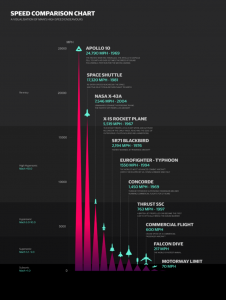
Note. The chart outlines relative speeds from automobiles through a line of flying vehicles with a timeline of speed advancements.
Source: (Kynvin, J., & Guardian Digital Agency, 2011)
Speed and distance
Once there is a realization of how fast these vehicles can fly, it is important to conceptualize the distance they can travel in a short period. A simple formula not accounting for changes in acceleration and other factors will assist with this visualization.
d=s*t Equation 12.2
where:
d = the distance traveled over a given speed and time
s = the constant speed the object is moving
t = the time the object has been in motion for a given speed.
Based on this formula, objects traveling at Mach speeds can transverse a great distance in a relatively short period. To appreciate national security concerns surrounding hypersonic weapons, it is essential to have a good perspective of the speed these vehicles can travel and how that compares to relative distances covered and the associated time. The following table provides some measurements to illustrate the relationship.
Table 12.2
Speed, time, and distance comparisons at various Mach speeds from 1-30 and times to cover 1000 miles

Source: (Kynvin, J., & Guardian Digital Agency , 2011) Photo conversion by author to meet PB specifications
Based on the above chart, if we were to use an object traveling at Mach 7, we would observe that the object is traveling at 5,328.4 miles per hour or 1.48 miles per second and will travel 1,000 miles at this speed of 11.26 minutes. By comparison, a car would take approximately 16 hours and a commercial flight approximately 2 hrs. And 20 min.
Figure 12.2
Commercial flight time from New York City to Orlando Florida

Source: (Google Maps, 2022)
The extreme speeds of hypersonic weapons bring challenges for any country trying to perform threat analysis and make launch intercept decisions. Such weapons can reduce the available time to make such decisions from hours to minutes or less. This will be discussed later in the chapter.
Types of hypersonic missiles
There are two categories of hypersonic devices currently under various stages of research and development, although some countries have claimed to have deployed them into active service. The two categories are the Hypersonic Cruise Missile (HCM) and the Hypersonic Glide Vehicle (HGV).
Figure 12.3
Categories of Hypersonic missiles

Note: Examples of a Hypersonic Cruise Missile and Hypersonic Glide Vehicle.
Source: (Brimelow B., 2018)
The HCMs are extremely fast Cruise Missiles powered by a SCRAM jet engine and can be launched from various platforms. They are self-propelled, which allows them to acquire alternate targets within their travel range, usually extended beyond gravitational pull. The X-43A (an experimental NASA vehicle) claims to have reached a speed of Mach 9.6 or approximately 6,800 mph or close to 2 miles per second (NASA, 2016) and, at this speed, will travel 1,000 miles in almost 8 minutes.
In contrast to the HCMs, the HGVs are not self-propelled and are solely dependent on gravity. These are also called Boost Glide Vehicles and are placed at a high altitude via an ICBM (Inter-Continental Ballistic Missile) type booster or space platform. The HGV becomes the booster’s payload, which replaces the typical re-entry vehicles, previously known as Multiple Re-entry Vehicles or MRVs. Once released from a platform in space or their IBCM transport, they are propelled via the pull of gravity and use their hull design.
Figure 12.4
HGV trajectories compared to a Ballistic Reentry Vehicle
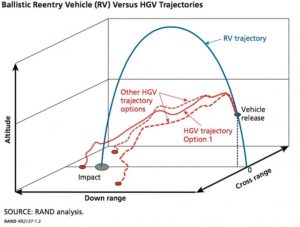
Note. Due to their type and design, the HGV can take a glide path that does not follow the same characteristics as a conventional Re-entry Vehicle (RV).
Source: (Speier, 2017)
The design of the HGV will allow it to glide to its target at hypersonic speed and generate lift via a process known as hypersonic aerodynamic lift. This would allow it to skip and glide across the atmosphere as it travels toward its toward. However, unlike the ballistic missile, the path does not need to follow a linear trajectory and can maneuver in all spatial plains for roll, pitch, and yaw. This level of control can be accomplished with very small control surfaces that can make tracking the vehicle difficult and enhance its capability to avoid a midair interception or even to avoid detection areas.
Figure 12.5
Detection avoidance
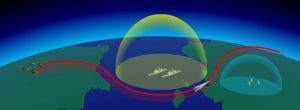
Source: (Brimelow B., 2018)
Types of Launch Platforms
Deployment platforms for the technology can vary greatly depending on the mission profile, type of missile, and theater of operation, as outlined in the following examples:
Stationary Land-Based launch platforms are typically launched from silos. They are typically used for booster rockets to lift heavy payloads and place an object into a high orbit, allowing it to take advantage of gravity to increase its speed.
Figure 12.6
Russia’s land-based silo launch

Note. Topol-M launch
Source: (Russian Defense Ministry/TASS, 2020)
Land-based mobile platforms permit launches to be achieved by transporting the missiles and can be moved from location to location. This can make it difficult to determine a precise launch location until after the device has been mobilized and or launched. Multiple types of these platforms are often used to launch multiple rockets batteries and cruise missiles.
Figure 12.7
India Mobil launcher
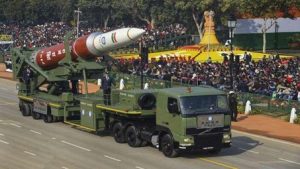
Note. Image courtesy: India TV. (India TV, 2020)
Sea/ocean-based launches can be performed from surface vessels, or submarines are currently equipped with subsonic cruise missiles. These provide a logistical advantage in positioning themselves closer to a target and providing ready capability. It also can spread out the launch area for optimal targeting. In the case of submarines, there is the ability to perform hit-and-run operations in that a vessel can surface and release, or it can provide a below surface launch and reduce its surface exposure.
Figure 12.8
Zircon Hypersonic missile ship launch
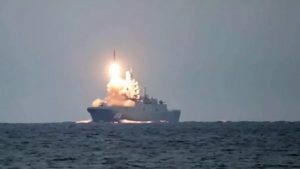
Note. Image courtesy: Russian Defense Ministry. (Russian Defense Ministry, 2020)
Airdrop launches can be performed from two sub-launch platforms. The first is an aircraft that will ferry the missile to a high altitude and release it. This provides the altitude and speed to allow the missile to optimize fuel and provide sufficient speed to force air through its engines. Additional details on engine technology will be discussed later in the chapter.
In addition to aerial drops, there is the possibility to perform a space platform drop from a low or medium orbiting space platform. This has an advantage in which minimal fuel needs for the vehicle.
Figure 12.9
Aircraft launched a hypersonic missile.

Source: (Industry tap into news, n.d.)
Power Plants / Propulsion systems
Hypersonic aircraft have two distinct characteristics which overcome obstacles for traditional jet engines. First, they fly extremely fast, and secondly, they cruise at very high altitudes. This requires an engine that will intake air at near hypersonic speeds and operate at an altitude where the air is extremely thin. This need has led to the development of the Scramjet, short for Supersonic Combustion Ramjet. This engine is the successor to the turbine and ramjet engines. The Scram and Ramjets operate differently from the jet turbine currently used on most commercial aircraft. The following illustrates the two different engines (focus will be on the turbine and Scram) and their characteristics.
Turbines or turbojets are designed to intake air via a set of high-speed rotating turbine blades and compress the air into what is known as a diffuser (which affords some cooling of the compressed air) which is then pushed into a combustion chamber. The compressed air is mixed with fuel and ignited in the combustion chamber. The resulting blast pushes the air out of the exhaust, which will spin exhaust fan blades connected to the intake blades, again intaking additional air. This process is referred to as the Suck, Squeeze, Burn, Blow principle.
Figure 12.10
Cutaway diagram of a basic jet engine
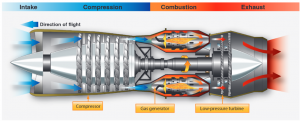
.
Source: (FAA, 2022)
These engines are extremely efficient at higher altitudes and generally cruse between 20,000-40,000 feet to obtain the best efficiencies of flight and fuel. The modern turbojet engines found in a fighter jet can reach 50,000-65,000 feet service ceilings. However, altitudes reach a little over 100,000 feet and a speed of approximately Mach 2.5 (Boeing, n.d.) The turbine engine loses efficiency in this general altitudes and speed range and will usually flame out due to oxygen deprivation.
Supersonic-combustion ramjet, aka Scramjet, unlike its predecessor, the turbine, does not have a complex component structure composed of numerous moving parts; it has none. The turbine engine requires a complex set of rotary compressors to suck in and compress the air, containing the oxygen necessary to sustain fuel burning. On the other hand, the scramjet obtains its compression by ramming air into its intake by traveling at a high-speed velocity.
Figure 12.11
Cutaway diagram of scram engine.
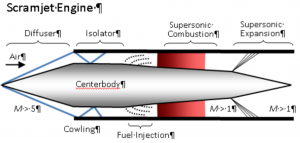
Sourced : (University of Washington, 2015)
This lack of a compressor requires a high speed which requires a launch from a rocket or aerial drop. A speed in the Mach 3+ range is needed for proper compression. This need typically requires a wide or long intake to channel the air being forced into the engine. Other changes in the pressure can be managed via the inlet and diffuser design leading into the combustion chamber. However, to increase the amount of thrust generated, it is essential not to decrease the speed at which airflow is passing through the system. Unlike a ramjet, the scramjet design ensures that the airspeed maintains a supersonic velocity as it passes from intake through combustion to an even higher exhaust acceleration to obtain very high Mach speeds. Therefore, if we were to follow through on Newton’s Second Law of motion applying to force and object mass:
Figure 12.12
General thrust equation
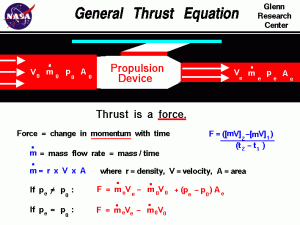
Source: (NASA, 2021)
we could derive the general thrust equation
F = (m dot * V)e – (m dot * V)0 + (pe – p0) * Ae Equation 12.3
Where:
Ae = exit area
dot = indicates the variable changes in time
e = exit station
F = force
m = mass of the object
O = freestream
P = pressure
V = velocity
The equation makes some profound implications related to the production of thrust. “…make the exit velocity much greater than the incoming velocity…A moderate amount of flow is accelerated to a high velocity” (NASA, 2021). This principle allows the scramjet to obtain and maintain a high supersonic/hypersonic airflow and generate high thrust. The engine design can surpass the speeds of Mach 10, which have already been achieved. However, other aerodynamic and physical processes must be addressed with such increases in speed. These will be discussed later in the chapter.
Technology Considerations for Hypersonic
Although many of the countries mentioned are making claims of missiles achieving extremely high-end Mach speeds, some of the claims may be unlikely at the present point in time due to inefficiencies in existing and associated technologies. In 2018, Russia claimed it had developed and tested a Mach 20 capable weapon, and “Recently Russia claimed to have developed a weapon that could travel at Mach 20. As stated by Putin, “The Avangard is invulnerable to intercept by any existing and prospective missile defense means of the potential adversary,” and they continued to add that the weapon was expected to enter into Russian service the following year (Shalini, 2018). However, this has not been proven, and any research attempts to obtain such a speed, with what would be considered a hypersonic weapon at Mach 5 and greater speeds, have disintegrated the vehicle, highlighting numerous challenges that must be addressed to achieve such a feat. Besides achieving and maintaining such a super hyper-speed, it will be necessary to overcome some of the following obstacles:
Aerodynamic heating and airframe construction are two such concerns that must be accounted for when traveling at speeds of Mach 5 and greater through the atmosphere. These extreme environmental concerns result from heat generation and transference, which must be adequately managed to keep the vehicle from heat damage and drag management associated with the airframe design (Deloitte, 2020). To manage heat transference, current vehicles moving at speeds close to Mach 20 or above have only been documented by space vehicles upon reentry, for example, the Space Shuttle and the Apollo capsules. One other has been HTV-1 and HTV-2 (there were two tests with HTV-1 type vehicles) destroyed by the heat during their research flights. According to NASA, as outlined in their Orbiter Thermal Protection fact sheet, the space shuttle travels more than 17,00 mph, roughly Mach 20, and uses the atmosphere as a friction brake to slow down. During the deceleration process, the outside surface can reach temperatures up to 3,000 oF or 1,648 oC.
The following provides a comparison of common metals that will melt at or below these temperatures:
Table 12.3
Melting temperatures of 10 common metals.
| Atomic # | Element | Melting Point (°C) | Melting Point (°F) |
| 26 | Iron | 1538 °C | 2800 °F |
| 28 | Nickel | 1453 °C | 2651 °F |
| 29 | Copper | 1084.62 °C | 1984.32 °F |
| 79 | Gold | 1064.18°C | 1947.52°F |
| 47 | Silver | 961.78°C | 1763.2°F |
| 13 | Aluminum | 660.32 °C | 1220.58 °F |
| 12 | Magnesium | 650 °C | 1202 °F |
| 30 | Zinc | 419.53 °C | 787.15 °F |
| 82 | Lead | 327.46°C | 621.43°F |
| 50 | Tin | 231.93°C | 449.47°F |
Source: (AE Toolbox, 2022)
The NASA fact sheet highlights the need to keep any internal components and structures below a certain temperature range because of damage to the airframe and internal systems. “Although the orbiters were built using highly advanced construction methods and materials, the airframe is formed primarily from aluminum and can only withstand 350 F without the material annealing or softening. The purpose of the thermal protection system is to ensure that the aluminum airframe does not exceed this 350-degree limit.” (NASA, n.d.).
It should be noted that the information previously provided from the NASA fact sheet is regarding the Space Shuttle (Orbiter), which is a very large piece of machinery as opposed to a cruise-type missile. Because of its size, it can carry additional thermal protection and has a larger protective plume. With that said, its protection systems have the following weight profile based on the type of tiles used in the various areas:
Figure 12.13
Tile weights per cubic foot for the Thermal Protection System tiles used on the STS Orbiter
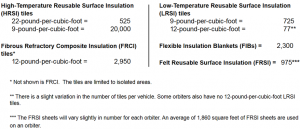
Source: (NASA, n.d.)
Smaller devices traveling at high speeds will still need to contend with the concern of heat displacement and protection of critical electronic components as-well-as structural integrity of the reentry vehicle. An object traveling at Mach 5 can incur temperatures of 1800°C (3,272°F) on its leading edges. Likewise, the same object traveling at Mach 15 could expect approximately 6000°C (10,832°F) on the same surfaces. This poses a severe engineering challenge with existing materials:
Table 12.4
Common Critical Electronic materials
| Atomic # | Element | Melting Point (°C) | Melting Point (°F) |
| 6 | Carbon (graphite) | >3527 °C | >6381 °F |
| 74 | Tungsten | 3422°C | 6192°F |
| 75 | Rhenium | 3186°C | 5767°F |
| 76 | Osmium | 3033°C | 5491°F |
| 73 | Tantalum | 3017°C | 5463°F |
| 42 | Molybdenum | 2623°C | 4753°F |
| 41 | Niobium | 2477°C | 4491°F |
| 77 | Iridium | 2466°C | 4471°F |
Source: (AE Toolbox, 2022)
Since any projectile or vehicle traveling at such speeds would need to overcome the melting temperatures of composites such as Hafnium Carbide, which have melting points of approximately 3958°C (Precision Ceramics EU, 2021), as well as Carbon Graphite. Because of these limitations, a projectile or missile traveling at such speeds in the atmosphere would likely disintegrate as it accelerates towards a speed of Mach 20. An example of such a breakdown at the extreme speed of Mach 20 and temperatures of >1900°C (3500°F) is the DARPA Hypersonic Test Vehicle (HTV-2). There were two flights lasting approximately 9 minutes. The reporting of lost signals in both flights and the vehicles crashing into the ocean (Plummer, 2011); ironically, communications interruption was experienced at the same in-flight time for both test flights. Some reports indicate that “A DARPA engineering review board found” most probable cause of the HTV-2 Flight 2 premature flight termination was unexpected aero-shell degradation, creating multiple upsets of increasing severity that ultimately activated the Flight Safety System.” (Malik, 2012).
This illustrates concerns related to the technology associated with heat management based on existing surface materials. There are alternate technologies associated with hull designs that will act as heat sinks, along with cryogenic cooling of the missile with a circulation of the liquid fuel through the hull. Such designs cooling designs beg additional considerations and investigation since a decrease in cooling efficiency will occur as there is a reduction in fuel and cooling based on fuel depletion. This could potentially expose the remaining fuel to an increasingly hotter hull. This also does not account for any potential shifts in weight, which would be a critical factor to include in any compensating calculations.
Navigation, guidance, and control systems are also areas of concern. Almost every aspect of modern warfare is based on electronic components, all of which have operational ranges associated with environmental such as heat, humidity, voltage fluctuation, ionization, etc. Based on decades of knowledge derived from satellite instrumentation, it is known that “The maximum structure temperature is still far higher than the temperatures that would cause degradation and failure to electronic components…Components can be subjected to temperatures as low as –55°C (–67°F) and as high as 125°C (257°F)… These thermal conditions can induce several failure modes, including package and die cracking, bond-wire breakage, moisture ingress, die delamination, tin whisker growth, and solder-joint failure.” (Electronic Products, 2019). Any internal temperature that would far exceed such numbers would bring a failure to the systems that maintain communications and flight control of the vehicle or weapon. To control a hypersonic missile or projectile, it will be necessary to provide signaling to control surfaces. That is typically performed via fly-by-wire technology controlled by internal electronics. The electronic transmissions to the control surfaces will come from the electronic components that must be protected from the extreme environments created by hypersonic travel.
A major part of any navigation system will be communications. Upon any high-speed vehicle’s re-entry into the atmosphere, a couple of phenomena occur. First, there is the heating of the air due to friction of the air molecules rushing over the craft’s hull. A shockwave follows this once the sound barrier is broken at Mach 1. In the hypersonic, above Mach 5, and the high-Hypersonic, Mach 10 and above, the shockwave adds to the temperature and atmospheric friction. The extreme heat, as previously discussed, c changes the chemical make-up of the oxygen and nitrogen in the air and causes the release of electrons which ionizes the air creating a plasma field surrounding the moving object (Nelson, 2020). In the case of the Orbiter or other spacecraft performing atmospheric re-entry, this ionization causes a communication blackout. In the case of the Mars Pathfinder, communications were lost with Earth for approximately 30 seconds (Morabito, 2002). A hypersonic projectile traveling at Mach 10 could travel over 63 miles in that short period with potentially only autonomous control. However, this would potentially exclude any communications with GPS systems baring new communications technology such as advanced X-ray technology or a large enough vehicle that the plume left an opening to allow a communications hole. The lack of technology would limit the ability to perform course corrections from external sources.
Other considerations would be the immaturity of the Scramjet engines and accessory design. For example, a critical component of the engine is the intake. There have only been a few very effective techniques to maintain the massive airflow and minimize any reductions in pressure. One is the development of a long intake, as presented by the Bussmann intake, and another is the management of shockwaves to manage the flow to avoid unstart conditions (Krishnan et al., 2009). However, the latter is very dependent on boundary layer flow which is very difficult to calculate at higher Mach speeds. The highest-rated wind tunnel in the U.S. is the LENS II Hypervelocity Tunnel, rated at Mach 15 (Holden, 2002). It is also reported that China is currently working on one that will be rated at Mach 30. Therefore, other than actual flights and data collection from sensors, the location of the hypersonic boundary layer is based on simulation and mathematical models, which may not be actual. This does not account for other factors such as proper fuel mixing and ignition within the combustion chamber, which is all timing and must be continuous for sustained powered flight. This does not account for the materials within the engine that must sustain high stress and temperatures for the flight’s duration.
An additional noteworthy discussion point is that there is a direct contrast between stability and performance in aviation. Pilots do not start out flying high-performance aircraft. They will begin with a more stable and forgiving form of a trainer. As they progress, they work their way up to high-performance aircraft that are inherently less stable because there is a trade-off between performance and stability. In addition, to the typical aircraft systems of propulsion, airframe, wings, and aerodynamic control surfaces, the more complex or high-performance aircraft have numerous subsystems to monitor and provide correction to the critical engine, environmental, and sensor components that assist the pilot with critical maneuvers that could not be performed without their aid. In addition, to these mentioned subsystems, others support communications and navigations and play a critical role in any in-flight vehicle, especially one traveling at hypersonic speed. Although an HGV would not need systems for monitoring population systems, some of the other systems illustrated in the diagram below would still apply (Brockmann, 2022).
Figure 12.14
Cutaway diagram of the X-51A HCM with subsystems.
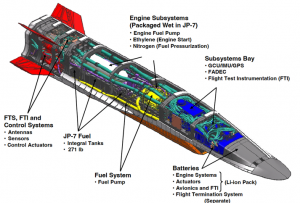
Source: J. Hank, J. M., Murphy, J. S. and Mutzman, R. C., ‘The X-51A Scramjet Engine Flight
Demonstration Program’, 15th AIAA International Space Planes and Hypersonic Systems and
Technologies Conference, May 2008, p. 7., (J. Hank, 2008)
“As the wedge-shaped vehicle rips the air apart at such high speeds, controlling the capsule at such speed is another challenge, requiring precise sensing and near-simultaneous response to flight path disturbances, requiring hybrid controls combining Reaction Control System (RCS) and aerodynamic effects.” (Eshel, 2011). This would require systems and monitors that provide flight data such as altimeter and pressure and airspeed and stability information, especially concerning the horizon. There would also be guidance, navigation, hydraulic and control systems that determine distance measuring and magnetic orientation along with gyroscopes or angular velocity measuring equipment, not to mention systems to manage electrical power distribution. In the case of most complex aircraft, these subsystems are very tightly coupled (NASA, 2006) and would need to be more so for the management of such a vehicle.
Enhanced computer technology associated with the hypersonic platforms will need the ability to provide computational power for areas similar to, but not limited to: ”
- mission computing, focused on responding to commands, adjusting to changing conditions, and ensuring that all subsystems work in concert to accomplish a platform’s mission.
- flight computing, controlling the platform’s path, monitoring the outputs of sensors, and controlling the operational employment of sensors.
- real-time signal processing for radar, electro-optical sensors, and electronic warfare (EW);
- and flawless and secure communications with command-and-control networks.” (Wilson, 2020)
It is important to note that re will be a need to realize the distinction between flight and mission computing as a weaponized device that must be performing real-time computing activities requiring massive computing resources and preemptive logic calculations to maintain flight control signaling. The transmissions to the control surfaces will come from the computer(s) and electronic components that must be protected from the extreme conditions previously discussed and maintain constant and consistent communications between themselves, which is a major technological challenge.
Military Application and Threats
The types of vehicles and weapons known to travel at hypersonic speeds, the type of powerplants that can produce thrust at Mach 5+ speeds, and the various deployment methods such weapons can be dispensed from are all important. Some of the technological challenges associated with hypersonic technology were highlighted, begging to question what parts fact vs. fiction are and what is an immediate threat vs. posturing of all sides.
With the previously mentioned knowledge, we can determine that the speed alone of these devices can make for a formable weapon. This, coupled with maneuverability and the ability to evade current defensive countermeasures, potentially makes the technology a force to be addressed from an offense and defensive perspective.
The technology needed to create a hypersonic weapon is not trivial. Numerous technological hurdles must be overcome to create a reliable weapon system. These hurdles would require a country with access to the most modern materials science, populations, computer, and engineering technology. It would also require a massive financial investment to perform the needed Research and Development, even testing a prototype of such a device, consuming large sums of the country’s budget. However, there are many countries currently working to achieve such.
Figure 12.15
Countries pursuing hypersonic weapon technology
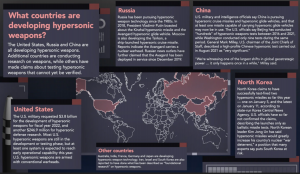
Source: (VOA Graphics, 2022)
Of these countries, China, India, North Korea, Russia, and the United States have alleged to have created test vehicles and performed flights using the technology. The vehicles that have been reported to be tested for each nation are:
Table 12.5
Listing of countries with their hypersonic devices and associated speeds and distances

Source: (USAF, n.d.) Photo conversion by author to meet PB specifications
Note. The information presented is based on claims and may not be actual speeds and distances. This also does not include sustained speeds or time at speed information. There may also be variations based on booster assistance.
Since it has been established there is a likelihood of technological and manufacturing, misinformation, exaggeration, and posturing, it is difficult to compare the claimed technology that each country may have. To provide some relative context of the weapon platform’s potential, the averages of the Mach speeds and ranges have been used based on the above table and are as follows:
Mach 8: Average estimated speed
1189 miles: Average estimated range
9.84 minutes: Average estimated time to travel 1000 miles
Note: These times appear to be on the higher end but are based on the averages of the available information.
For context, a few scenarios may provide additional perspective on the distances that can be covered in a short period and why a missile or any other fast-moving weapon, time becomes the critical factor.
The following figure depicts a hypersonic attack on NATO countries (shaded in gray) from a seaport in Kaliningrad or possibly a missile cruiser in the Baltic Sea, with hypersonic weapons trained on London and Berlin, and Warsaw.
Figure 12.16
Attack scenario against 3 NATO countries from a Baltic based launch

Source: (NATO, n.d.)
In the case of a launch towards London, which is approximately a distance of 880 miles, the scenario missile traveling at Mach 8 would cover that distance in approximately 8 minutes and 40 seconds. This is more than twice as long as the flight to Poland, which has a distance of approximately 330 miles and will receive its delivery in an estimated 3 minutes, 15 seconds. Warsaw, Poland, is approximately 180 miles distance and could expect a strike in approximately 1 minute and 46 seconds. Although these are raw numbers and don’t account for launch and initial acceleration, they paint a fairly good picture of how fast these weapons can arrive at a target before the opposing force can react.
Another scenario may be that of China and its ability to launch from multiple locations against numerous targets in the Pacific and South China Sea.
Figure 12.17
Distances between possible Chinese launch sites and targets in Korea, Japan, and Taiwan

Source: (Google Maps, 2022)
With the short distance on the coast of China, for instance, a base near Qingdao could send a Mach 8 missile to Osaka, Japan, in approximately 8 minutes and Sole Korea in approximately 3 minutes 46 seconds. Continuing to use Mach 8 and a launch from Quanzhou, China, a missile would reach Taichung City, Taiwan, in approximately 1 minute and 32 seconds. In the situation of Taiwan, there would be no time to react or alert or for the population to seek shelter. From a more strategic perspective, China could quickly deliver a hypersonic weapon to almost any point in the South Pacific in less than10 minutes. Based on the anticipated ranges of the deployable weapons, this would include the Philippines and nations that border China.
Figure 12.18
Various ranges for ballistic coverage from eastern Chinese missile launch facilities cover the south Pacific.

Source: (Lockie, 2019)
With these times and based on the existing ballistic missile technology, it is difficult to defend against hypersonic weapons. According to Richard Speier, an adjunct staff member with Rand, “We don’t currently have effective defenses against hypersonic weapons because of the way they fly, i.e., they’re maneuverable and fly at an altitude our current defense systems are not designed to operate at, … Our whole defensive system assumes that you’re going to intercept a ballistic object.” (Macias, 2018)
Based on the previously defined assumptions related to weapon speed and distance and a non-ballistic trajectory, it is feasible that China could launch an attack against the US and the interest of other countries that would use the shipping lanes of the South China Sea connecting East Asia and India, Western Asia, Taiwan, and the Luzon Straits. An attack on a vessel at sea would have a very little warning or time to react to a hypersonic weapon assault. In short, the first one to strike would have an advantage since the reaction time for the other side has been dramatically reduced.
Figure 12.19
Illustration of China’s hypersonic tests
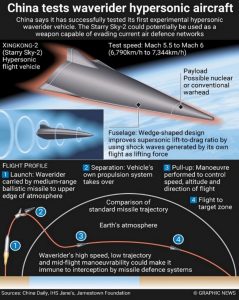
Source: (Pileggi, 2019)
Time is everything, and as a result, “…the adversaries have increasingly focused on systems that dramatically compress the timelines and the timescale of a tactical battlefield. These systems — including ballistic missiles, ballistic missiles with maneuvering reentry vehicles, and vehicles increasingly hypersonic in nature — give adversaries the ability to hold our forces at risk from hundreds, even thousands, of miles away, with flight times that are measured in minutes.” (Cronk, 2021)
One of the existing decision strategies is the OODA-loop, created by Air Force Colonel John Boy; it is an acronym for Observe, Orient, Decide, and; it is an iterative strategy that will allow one to make decisions and act on them quicker than their opponent, therefore, disrupting the opponent’s loop and giving an advantage. In the case of an incoming missile, this loop is the time to observe the incoming bogie, orient by determining where it is heading and if it is hostile, determine to intercept and or retaliate then t finally act on that action (Wikipedia, 2003)
Figure 12.20
The Observe. Orient. Decide. Act-Loop

Sourced from: (Wikipedia, 2003)
Executing the loop takes time, beginning from the point of observation, which is a key distinction and important point. Hypersonic weapons are a disruptive technology that has required the need for technology to perform early detection, which will increase the time available for orientation and determination, time to decide then act. However, even with early detection, the other areas of the loop may not have sufficient time to react due to the lighting speed of the hypersonic weapon. The new technology has taken the OODA-Loop from minutes to seconds, making orientation, decisions, and acting so fast that humans may no longer be able to do such. The following table provides some approximate time estimates that currently exist for making a launch determination using ICBMs.
Table 12.6
Steps and times from observation to launch decision for incoming ballistic missile
| H Missile launch | |
| H+1 min | U.S. infra-red satellite detects hot plumes from Russian ballistic missiles during the 4-7-minute-long boost phase of flight. Satellites instantly transmit the detection data to early warning teams at NORAD, STRATCOM, NMCC, ANMCC, and other facilities. Russian stealthy cruise missiles launched from stealthy submarines patrolling off the U.S. coasts likely elude detection throughout their flight to targets. |
| H+4 min | NORAD and STRATCOM early-warning teams must report initial confidence (no, medium, or high) of nuclear missile threat to North America. NORAD and STRATCOM Commanders are notified and briefed on the apparent threat. |
| H+4 to+9 min | If confidence is medium or high, POTUS is notified, and reachable advisors are dialed into teleconference or video conference. |
| H+9 to +10 min | STRATCOM Commander briefs POTUS on the threat and response options along with their consequences (mainly civilian casualties in Russia) and makes a recommendation. |
| H+10 to +15 min | BMEWS ground radars detect missiles in mid-flight. Early warning teams confirm an attack underway, and computers update predictions of impact areas and targets. |
| H+10 to +17 min | POTUS is updated by briefers, deliberates, and may confer with other advisors. |
| H+17 to +17.5 min | POTUS informs Pentagon War Room (the emergency actions center of the NMCC, which has been monitoring the conference since its beginning) of the response option to be executed. NMCC challenges POTUS to authenticate their identity using “Gold Codes.”4 |
| H+18 to +20 | min War Room (NMCC or alternate) formats and transmits launch order (1/2 length of a Tweet!) directly to SSBNs, ICBMs, and bombers (as well as the entire chain of nuclear command). Order contains the time of launch, option to execute, unlock codes, and special authentication codes.5 |
| H+20 to +22 min | ICBM, SSBN, and bomber crews authenticate messages using special authentication codes in their possession. ICBM crews target missiles by chosen war plan, unlock (enable) missiles selected for launch, and transmit launch signals |
| H+22 to +27 min | ICBMs instantly fire out of silos over pre-programmed 5-minute fly-out salvo. |
| H+27 to +30 min | Incoming Russian warheads begin to detonate on CONUS. |
| H+35 to +40 min | U.S. SLBM launches begin; 1 every 15 seconds for each SSBN. |
| H+50 to +60 min | U.S. ICBM and SLBM warheads strike Russian targets. |
| H+8 hrs. to +12 hrs. | CONUS-based U.S. bombers begin firing cruise missiles or dropping bombs. |
Note. The above provides time estimates based on a U.S. decision to launch a nuclear missile upon warning of an enemy attack. Source: (Blair, 2019)
The difference in time for a hypersonic missile to be launched and delivered to its target 1000 miles away at a speed of Mach 8 could be under 10 minutes. Likewise, a closer target, such as an aircraft carrier at 100 miles, would have less than 1 minute to observe, orient, decide and act. In the case of an aircraft carrier, it is most likely the vessel will be lost. In the case of a larger target, such as a city within the 1000-mile range, there will be little chance of any occupants being able to obtain reasonable shelter in the available time.
Doctrines, Policies, and Strategies in an era of hypersonic weapons
To continue with the topic of offensive and defensive strategies, as they relate to hypersonic weapons, it is important to have a brief understanding of how they interact because they will determine how investments are made, what systems are deployed, and where, along with how a country may use such technology to react/not react to an actual or perceived threat. To have this conversation, we need to start with the concept of doctrine, which is the highest level of the three. This is the concept, belief, or ideology from which policies and strategies are developed. For example, general emphasis or at least espoused doctrines of the US, Russia, and China are along the lines of:
- the United States has the US Constitution, which advocates separation of powers, church, and state with concern for the rights and freedoms of the individual. It also is built on the concept of publicly elected officials by national vote and a “principle” of a peaceful transfer of power.
- Russian Federation, as stated in part of a policy concept, “To ensure reliable security of the country, to preserve and strengthen its sovereignty and territorial integrity, to achieve firm and prestigious positions in the world community, most fully consistent with the interests of the Russian Federation as a great power, as one of the most influential centers of the modern world, and which are necessary for the growth of its political, economic, intellectual and spiritual potential.” (Russian Federation, 2000)
- the People’s Republic of China, under the Xi Jinping doctrine, focuses on “the mission of the Chinese Communist Party.”…” national rejuvenation,”…” global community,” and “Chinese contribution. Xi says, “Chinese people will never allow any foreign force to bully, oppress, or subjugate us….” (Xinhua, 2021)
From their doctrine(s), a country will develop various policies supporting those doctrines, leading to strategies and tactics that will enforce or bring those policies to fruition. In the case of some countries, there may be the doctrine to expand or warmonger and, as such, may have little apprehension to taking advantage of a preemptive assault if there is a reasonable presumption they could do so and avoid any repercussions of a retaliatory strike.
As previously discussed, the speed at which hypersonic weapons travel, any country that has a command of this technology could use it for retaliatory or preemptive actions and do so before the opposition could react, therefore providing those with the technology with additional strategic and tactical options compared to those from previous generations of warfare. When working with aircraft and ballistic missiles, the OODA loop was an effective strategy because it would provide an iterative process of what would be considered a, by today’s standards, an elongated time to decide and react therefore disrupting the OODA loop of the opponent there is no longer sufficient time for humans to react effectively with the incredibly short periods.
Figure 12.21
Cruise missiles launch footprints and travel times to target
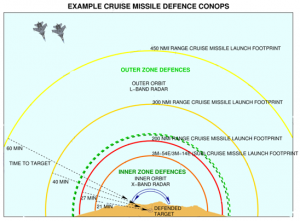
Sourced: (Kopp, 2014)
Using the above Cruise missile footprint diagram. Launching a Cruise missile airdrop of 200 miles would require approximately 27 minutes to target. In the same scenarios, deploying a Mach 8 missile at an aircraft carrier or other target 200 miles away would provide the ship’s captain approximately 2 minutes to react. In the event of an airdrop or ship launch, it is very foreseeable that multiple missiles could target and overcome multiple aircraft carriers in a fleet.
In addition to speed, there is a high degree of mobility. A guided weapon can perform deceptive target acquisition by altering its flight path and redirecting to another possible target within its acquisition range. Again, this would provide another degree of uncertainty about what assets to protect. The possible coverage of such a missile is outlined in the diagram below.
Figure 12.22
Possible target coverage ranges of a Hypersonic Glide Vehicle

Source: (Delcker, 2019)
In selecting a strategy, it is essential to understand the strengths and weaknesses of one’s defenses and those of the Opposing Force. It is also important to understand that the element of surprise can benefit the initiator of a preemptive strike. Therefore, it is important to realize there may be multiple short- and long-term strategies for various theaters of operation. For example, there could be a separate strategy for an offensive posture such as preemptive or even retaliatory strike doctrines, such as Mutually Assured Destruction/Deterrence, ensuring the destruction of all opposing sides, or an initiative to develop defense systems based on advanced technology. This would all depend on the doctrines, policies, and determining strategies of the countries involved.
As an example, there are currently parties in the Department of Defense that believe the Peoples Republic of China (PRC) may have some level of credibility in their stated deployment of hypersonic technology and realize their aggressive activities to develop such technology via their 2025 plan, as well as creating fortifications in the East and South China Seas, from which numerous weapon platforms can be launched. China’s People’s Liberation Army (PLA), according to the Office of the Secretary of Defense, has stated that “The PLA is developing capabilities to provide options for the PRC to dissuade, deter, or, if ordered, defeat third-party intervention during a large-scale, theater campaign such as a Taiwan contingency.” (DoD, 2020). Depending on where weapons are launched from China, a Mach 8 hypersonic missile could hit Taiwan in under 2 minutes and vice versa. Chinese defense strategy has already considered these possibilities, and “The PLA argues that the implementation of “intelligentized” capabilities will increase the speed of future combat, necessitating more rapid processing and fusing of information to support quick and efficient command decision making. According to PLA strategists, victory in future warfare will depend upon which side can more quickly and effectively observe, orient, decide, and act in an increasingly dynamic operating environment.” (DoD, 2020) . In the US, there has already been an acceptance that some “. “S. defense officials have stated that both terrestrial- and current space-based sensor architectures are insufficient to detect and track hypersonic weapons, with former USD(R&E) Griffin noting that “hypersonic targets are 10 to 20 times dimmer than what the U.S. normally tracks by satellites in geostationary orbit.” (DoD, 2020)
As the weapon delivery systems become quicker, reducing the OODA-loop times, and the self-awareness that no one country may have the technical capabilities to defend against this emerging technology, strategies will change to a more reactive posture. The existing policies and tactics based on arcane ICBM strategies may change from a DEFCON type system with various levels of readiness working up to a “Launch On Warning” that may not become a “Launch On Detection.” This may further be acerbated by the deployment and integration of such technologies as low-altitude satellites as dedicated tracking sensors across the globe, providing a Wide Field Of View (WFOV) for launch detections. This is currently underway with US government contractors (DoD, 2020) and the possibility of space-based countermeasures. In any event, a current US strategy is to invest in technology to not only develop hypersonic technologies but to also defend against them with the US, “Hypersonic weapon-related and technology development is widespread across DOD and includes supporting efforts by DOE and NASA, such as basic hypersonic research and reimbursable testing. Reported received and planned future funding substantially increased from 2015 through 2024 and is currently estimated to total almost $15 billion.” (GOA, 2008) China is also making a major investment in technology and advanced weapons as part of its goal to be self-sufficient by 2025.
Summary
Aviation and its associated technology have evolved from the first flights of the Wright Brothers to supersonic jets to devices in the high-hypersonic range. They can transition the planet in approximately 90 minutes or less. This same technology has advanced to the state where waring countries can deliver weapon systems to targets in under 10 minutes for what once took over 30 minutes or even hours. These advancements will require nations to reconsider their military and Civil Defense policies. Because of the speed at which technology can move, the time allotted to Observe, Orient, Decide, and Act has been vastly decreased. These short intervals may no longer provide the time necessary for humans to collect the needed information and make a launch/no launch decision. Going forward, such decisions may be made by complex systems employing Artificial Intelligence to collect, analyze, and decide the fate of the moment and the retaliatory actions that will occur after that. This should leave us to wonder if we are on the cusps of Colossus: The Forbin Project.
Bibliography
AE Toolbox. (2022, Mar 31). Melting Points for 10 Common Metals. Retrieved from www.americanelements.com: https://www.americanelements.com/meltingpoint.html
Aero Corner. (2021, June 15). Thirteen fastest fighter Jets globally (+ 4 fastest jet aircraft). Retrieved from https://aerocorner.com/blog/fastest-fighter-jets/: https://aerocorner.com/blog/fastest-fighter-jets/
Blair, B. G. (2019, Oct). The U.S. Nuclear Launch Decision Process (on warning of incoming Russian missile). Retrieved from www.globalzero.org/: https://www.globalzero.org/wp-content/uploads/2020/11/Full-LOWTimeline.pdf
Boeing. (n.d.). Boeing: Historical Snapshot: F-15 eagle tactical fighter. . Retrieved from www.boeing.com: https://www.boeing.com/history/products/f-15-eagle.page
Brimelow, B. &. (2018, March 4). Hypersonic weapons can make virtually all missile defenses useless — and destabilize the world order. Retrieved from www.businessinsider.com: https://www.businessinsider.com/hypersonic-weapons-could-nullify-missile-defenses-2
Brimelow, B. (2018, April 30). Russia, China, and the US are in a hypersonic weapons arms race — and officials warn the US could be falling behind. Retrieved from www.businessinsider.com: https://www.businessinsider.com/hypersonic-weapons-us-china-russia-arms-race-2018-4
Brockmann, K. &. (2022, Feb 4). A matter of speed? Understanding hypersonic missile systems. Retrieved from sipri.org: https://sipri.org/commentary/topical-backgrounder/2022/matter-speed-understanding-hypersonic-missile-systems
Cronk, T. M. (2021, May 3). Defense official says hypersonics are vital to modernization strategy, battlefield Dominance. Retrieved from www.defense.gov/: https://www.defense.gov/News/News-Stories/Article/Article/2593029/defense-official-says-hypersonics-are-v
CSIS. (2021, July 31). CSIS Missile Defense Project. Retrieved from missilethreat.csis.org: https://missilethreat.csis.org/missile/avangard/
CSIS. (2021, Aug 2). CSIS Missile Defense Project. Retrieved from missilethreat.csis.org/missile/: https://missilethreat.csis.org/missile/df-17/#:~:text=Specifications%20The%20DF-17%20is%20solid-fueled%2C%20measures%20around%2011,as%20that%20used%20for%20China%E2%80%9
Delcker, J. (2019, Feb 8). China leads research into hypersonic technology: Report. Retrieved from defense.pk/: https://defence.pk/pdf/threads/china-leads-research-into-hypersonic-technology-report.600978/
Deloitte. (2020, April 9). The rise of hypersonics. Retrieved from www2.deloitte.com: https://www2.deloitte.com/us/en/pages/energy-and-resources/articles/rise-of-hypersonics.html
DoD. (2020). Military and security developments involving the People’s Republic Of China. Retrieved from media.defense.gov/: https://media.defense.gov/2020/Sep/01/2002488689/-1/-1/1/2020-DOD-CHINA-MILITARY-POWER-REPORT-FINAL.PDF
Electronic Products. (2019, April 11). A brief history of electronic reliability in space — including today’s risks and how to mitigate them. Retrieved from www.electronicproducts.com: Electronic Products. (2019, April 11). A brief history of electronic reliability in space — including today’s risks and how to mitigate them. Retrieved from https://www.electronicproducts.com/a-brief-history-of-electronic-reliability-in-space-including-to
Eshel, T. (2011, April 11). DARPA’s HTV-2 fails to complete the second hypersonic flight test. Retrieved from defense-update.com/: https://defense-update.com/20110811_htv-2_falcon_second_test.html
FAA. (2022). Ch. 16. Airplane flying handbook. Retrieved from www.faa.gov/: https://www.faa.gov/regulations_policies/handbooks_manuals/aviation/airplane_handbook/media/17_afh_ch16.pdf
Forca Aerea Brasileira. (2021, Dec 16). FAB realiza primeiro teste de voo do motor aeronáutico hipersônico 14-X. . Retrieved from fab-mil-br.translate.goog/noticias/mostra/38395/: https://fab-mil-br.translate.goog/noticias/mostra/38395/OPERA%C3%A7%C3%A3O%20CRUZEIRO%20-%20FAB%20realiza%20primeiro%20tes
GOA. (2008, July). Ballistic missile defense Actions are needed to improve the process of identifying and addressing combatant command priorities. Retrieved from www.gao.gov/: https://www.gao.gov/assets/gao-08-740.pdf
Google Maps. (2022, Mar 20). China to Japan, Korea, and Taiwan. Retrieved from www.google.com: https://www.google.com
Google Maps. (2022, March 20). NYC to Orlando. Retrieved from www.google.com/maps/: https://www.google.com/maps/dir/Orlando,+Florida/New+York,+NY/@34.5433045,-82.1817811,6z/data=!3m1!4b1!4m14!4m13!1m5!1m1!1s0x88e773d8fecdbc77:0xac3b2063ca5bf9e!2m2!1d-81.3789269!2d28.5383832!1m
Holden, M. S.-U. (2002). LENS Hypervelocity Tunnels and Application to Vehicle Testing at Duplicated Flight Conditions. Retrieved from arc.aiaa.org: https://arc.aiaa.org/doi/10.2514/5.9781600866678.0073.0110
India TV. (2020, Sept 18). Global military spending in 2019 was the largest in a decade; China and India are in top 3: SIPRI. Retrieved from www. newsclick.in: https://www.newsclick.in/global-military-spending-2019-largest-decade-china-india-top-3-SIPRI
Industry tap into news. (n.d.). x51 Waverider Hypersonic Missile. Retrieved from www.industrytap.com: https://www.industrytap.com/hypersonic-missiles-make-us-defense-systems-obsolete/36491/x-51-waverider-hypersonic-attached-b-52-bomber
- Hank, J. M. (2008). The X-51A Scramjet Engine Flight Demonstration Program. 15th AIAA International Space Planes and Hypersonic Systems and Technologies Conference (p. 7). AIAA.
Kopp, D. C. (2014, Jan 27). Defeating cruise missiles. Retrieved from www.ausairpower.net: http://www.ausairpower.net/Analysis-Cruise-Missiles.html
Kynvin, J., & Guardian Digital Agency. (2011, November 25). Speed comparison chart. . Retrieved from visual.ly/: https://visual.ly/community/Infographics/transportation/speed-comparison-chart
Lockie, A. (2019, April 2). China’s missiles could dust the US military in minutes — here’s what would happen if they tried. Retrieved from www.businessinsider.co.za/: https://www.businessinsider.co.za/chinese-missiles-could-hit-us-jets-ships-in-pacific-but-at-great-risk-2019-3
Macias, A. (2018, Mar 21). Russia and China are ‘aggressively developing’ hypersonic weapons — here’s what they are and why the US can’t defend against them. Retrieved from www.cnbc.com: https://www.cnbc.com/2018/03/21/hypersonic-weapons-what-they-are-and-why-us-cant
Malik, T. (2012, April 23). Death of DARPA’s superfast hypersonic glider explained. Retrieved from www.space.com/: https://www.space.com/15388-darpa-hypersonic-glider-demise-explained.html
Military-Today. (n.d.). Hwasong 8 ballistic missile with a hypersonic glide vehicle. Retrieved from www.military-today.com/missiles/hwasong_8.htm: https://www.military-today.com/missiles/hwasong_8.htm
Military-Today. (n.d.). Shaurya short- and medium-range ballistic missile. Retrieved from www.military-today.com/missiles/shaurya.htm: https://www.military-today.com/missiles/shaurya.htm
Military-Today. (n.d.). Tsyrkon anti-ship cruise missile. Retrieved from www.military-today.com/missiles/tsyrkon.htm: https://www.military-today.com/missiles/tsyrkon.htm
Morabito, D. D. (2002, Aug 15). The Spacecraft Communications Blackout Problem Encountered during Passage or Entry of Planetary Atmospheres. Retrieved from ipnpr.jpl.nasa.gov/: https://ipnpr.jpl.nasa.gov/progress_report/42-150/150C.pdf
N.O.A.A. ((n.d.)). Speed of sound. . Retrieved from www.weather.gov/: https://www.weather.gov/media/epz/wxcalc/speedOfSound.pdf
NASA. (2006, Jan 1). Integrated system health management (ISHM) technology demonstration project final report. Retrieved from www.researchgate.net/: https://www.researchgate.net/publication/246487548_Integrated_System_Health_Management_ISHM_Technology_Demonstration_Project_
NASA. (2019). Hypersonic tunnel facility. Retrieved from www1.grc.nasa.gov/: https://www1.grc.nasa.gov/facilities/htf/
NASA. (2021, May 13). General thrust equation. Retrieved from www.grc.nasa.gov/: https://www.grc.nasa.gov/WWW/k-12/airplane/thrsteq.html
NASA. (2022, dec 25). abc.com. Retrieved from Nasa.gov: nasa.gov
NASA. (n.d.). Orbiter Thermal Protection System. Retrieved from www.nasa.gov/: https://www.nasa.gov/centers/kennedy/pdf/167473main_TPS-06rev.pdf
NATO. (n.d.). NATO on the map. Retrieved from www.nato.int/nato-on-the-map/: NATO. (n.d.). NATO on the map. Retrieved from https://www.nato.int/nato-on-the-map/#lat=53.06502518704667&lon=10.138445588401366&zoom=0&layer-1
Nelson, D. (2020, Mar 14). Mach speed: From Mach 1 to Mach 3 speed and beyond. Retrieved from sciencetrends.com: https://sciencetrends.com/mach-speed-breakdown-examples-mach-1-2-3-beyond/#:~:text=The%20range%20of%20speed%20that%20exists%20from%20Mach,molecules%20of%20oxyg
Nilsen, T. (2021, July 19). Northern fleet frigate test fires Tsirkon hypersonic missile. Retrieved from thebarentsobserver.com/: https://thebarentsobserver.com/en/security/2021/07/northern-fleet-frigate-test-fires-tsirkon-hypersonic-missile
Pileggi, V. (2019, Jan 12). Pekin anuncia el despliegue de UN misil “asesino de portaaviones” después de Que UN buque de guerra estadounidense navegue cerca de los islotes del mar de China meridional. Retrieved from desarrollodefensaytecnologi: https://desarrollodefensaytecnologi
Plummer, M. &. (2011, August 11). Falcon HTV-2 hypersonic plane loses control in Mach 20 test. Retrieved from abcnews.go.com/: https://abcnews.go.com/Technology/hypersonic-flight-darpa-launches-htv-plane-test-loses-contact/story?id=14280849
Precision Ceramics EU. (2021, Nov 23). Hypersonic speed & ultra-high temperature ceramics. Retrieved from Precision Ceramics EU. (2021, November 23). Hypeprecision-ceramics.com/EU/high-temperature-ceramics/: https://precision-ceramics.com/eu/high-temperature-ceramics/
Russian Defense Ministry. (2020, Oct 7). Watch successful launch of Russia’s zircon hypersonic cruise missile. . Retrieved from sputniknews.com/: https://sputniknews.com/20201007/watch-successful-launch-of-russias-zircon-hypersonic-cruise-missile-1080691630.html
Russian Defense Ministry/TASS. (2020, January 16). A closer look at rearmament of Russian strategic nuclear forces. Retrieved from southfront.org: https://southfront.org/closer-look-at-rearmament-of-russian-nuclear-forces/
Russian Federation. (2000, June 28). The foreign policy concept of the Russian Federation. Retrieved from nuke.fas.org/: https://nuke.fas.org/guide/russia/doctrine/econcept.htm#:~:text=The%20Russian%20Federation%20is%20pursueing%20an%20independent%20and,states%20and%20i
Science Daily. (2021, September 19). Speed of sound. Retrieved from www.sciencedaily.com/: https://www.sciencedaily.com/terms/speed_of_sound.htm
Shalini, S. (2018, Dec 17). Russia tests nuclear-capable Mach 20 hypersonic missile successfully, overtaking US capability. Retrieved from www.ibtimes.com/: https://www.ibtimes.com/russia-tests-nuclear-capable-mach-20-hypersonic-missile-successfully-overtaking-us-2746
Smithsonian National Air and Space Museum. (2022). Hypersonic flight. Retrieved from airandspace.si.edu/: https://airandspace.si.edu/stories/editorial/hypersonic-flight
Speier, R. H. (2017). Hypersonic missile nonproliferation. Retrieved from www.rand.org/: https://www.rand.org/content/dam/rand/pubs/research_reports/RR2100/RR2137/RAND_RR2137.pdf
University of Washington. (2015, Oct 9). General features. Retrieved from www.aa.washington.edu/: https://www.aa.washington.edu/research/ramaccel/features
USAF. (n.d.). X-51A Waverider. Retrieved from www.af.mil: https://www.af.mil/About-Us/Fact-Sheets/Display/Article/104467/x-51a-waverider/
VOA Graphics. (2022, Feb 2). Graphic: Which countries are working on hypersonic weapons? Retrieved from www.voanews.com: https://www.voanews.com/a/graphic-which-countries-are-working-on-hypersonic-weapons-/6423803.html
Wikipedia. (2003, Nov 28). OODA loop. Retrieved from en.wikipedia.org/wiki/OODA_loop: https://en.wikipedia.org/wiki/OODA_loop
Wilson, J. (2020, May 22). The electronics design challenges of hypersonic flight. Retrieved from www.militaryaerospace.com: https://www.militaryaerospace.com/sensors/article/14176531/the-electronics-design-challenges-of-hypersonic-flight
Xinhua. (2021, July 1). Xi says Chinese people will never allow foreign bullying, oppressing, or subjugation. Retrieved from www.xinhuanet.com: https://www.xinhuanet.com/english/special/2021-07/01/c_1310037372.htm

